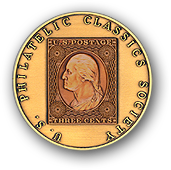from the Collections of Dr. Charles J. DiComo

An interesting septet with manuscript double-underlined “numeral” markings on 3¢ stamps with various handstamp cancels.
8L2L and 18L2L were once a vertical pair and both are cancelled with a blue Charleston, S.C. straight-line “PAID” handstamp. The 8L2L is dated APR 12 (with no. 122), while the 18L2L is dated APR 23 (with no. 145). Interestingly, the 80R2L is from B{ALTIM}ORE and also dated in April (with no. 125) suggesting it was marked in between the other 2 usages. Additionally, the second stamp has the manuscript no. “42” double-underlined in a “different” hand (Note: “4” & “2” stroke), and appears to be canceled on the 22nd or 23rd of February (“B” is visible) in BALT{IMORE}, Md. The first stamp at left has a manuscript “28” and a blue date “26” with not much else of the cancel visible (probably January 26th). The stamp at the upper left is black grid cancelled with only the double-underlines visible, which the stamp at upper right is black grid cancelled with a double-underlined no. 145. If you compare both stamps with the “145”, it appears they are in different hands as well.
Finally, the 8L2L and 18L2L appear to have been separated by some mechanical means. Is this an obscure or early form of rouletting? This does not appear to be the case as the spacing is not consistent. I thank Wilson Hulme for examining this once attached pair.
Is this a registered mail usage? Is this a private docketing marked on the stamps once received at a large firm to keep track of their incoming mail? I thank Gary Schrader for the following hypothesis:
“The numbers written on the stamps probably correspond to sequential line or page numbers in an accounts-receivable ledger used to record received payments, or all mail received, at a business establishment. Since the last three stamps all were written on in the same handwriting, but mailed from two distant cities, the writing must have been done at the receiving end. The different hand on the first stamp (number “42” on stamp postmarked Feb 22) simply could have been due to a different person annotating the incoming mail at the same firm on that day. The handwritten numbers follow a roughly linear progression with the month/day postmarks. If the business received only one or two pieces of mail per day, the numbers may correspond to ledger line numbers. If their incoming mail volume was significantly higher, the numbers may correspond to ledger page numbers.” Additionally, “although the different hand on the Feb. stamp changes things a bit, the number written on the fourth acquisition really strengthens my original theory by adding a fourth sampling to the sequential number theory. If you divide the number written on the stamp by the day of the calendar year, all the results fall in the ballpark of 1.2. If my theory is correct, the stamp with “125” was postmarked around Apr 13.”
If anyone has another hypothesis, I’d be interested in hearing from you. Moreover, if anyone has similar copies on or off cover, please let me know as I’d be interested in examining them first hand.

